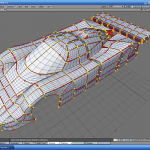 CAD jockeys among you have a clear idea of what a spline is: However, you may not realize that splines were once physical things. In an era prior to CAD and large-format printing, when draftsmen needed to lay out full-sized curves—for boatbuilding, airplane manufacturing and the like—this is how they did it: To be clear, the “spline” is the actual strip of wood being bent and held in place. The things holding it in place are called spline weights, or colloquially, “ducks” or “whales.” They weigh about five pounds apiece. Spline weights were typically cast in lead, then painted to prevent the user from transferring lead smudges from his hands onto the drawing. The bottom was lined in felt, to prevent tearing the paper it sat on. A protruding hook was used to pin the spline itself down. The surfaces of these heavy objects were purposely cast rough, which made them easier to pick up. In 2005 a company named Edson began manufacturing spline weights out of bronze rather than lead, to reduce the health risk. (It’s not clear if they manufacture them anymore, and I couldn’t find them anywhere on Edson’s website; outside of a handful of boatbuilding schools, no one has much use for spline weights these days.) Ironically, here are some splines of a spline weight. Anyways, next time you CAD jockeys are trying to massage the carpal tunnel out of your wrist, just be glad your mouse doesn’t weigh five pounds.
CAD jockeys among you have a clear idea of what a spline is: However, you may not realize that splines were once physical things. In an era prior to CAD and large-format printing, when draftsmen needed to lay out full-sized curves—for boatbuilding, airplane manufacturing and the like—this is how they did it: To be clear, the “spline” is the actual strip of wood being bent and held in place. The things holding it in place are called spline weights, or colloquially, “ducks” or “whales.” They weigh about five pounds apiece. Spline weights were typically cast in lead, then painted to prevent the user from transferring lead smudges from his hands onto the drawing. The bottom was lined in felt, to prevent tearing the paper it sat on. A protruding hook was used to pin the spline itself down. The surfaces of these heavy objects were purposely cast rough, which made them easier to pick up. In 2005 a company named Edson began manufacturing spline weights out of bronze rather than lead, to reduce the health risk. (It’s not clear if they manufacture them anymore, and I couldn’t find them anywhere on Edson’s website; outside of a handful of boatbuilding schools, no one has much use for spline weights these days.) Ironically, here are some splines of a spline weight. Anyways, next time you CAD jockeys are trying to massage the carpal tunnel out of your wrist, just be glad your mouse doesn’t weigh five pounds.
Read More:
When Splines Were Physical Objects





